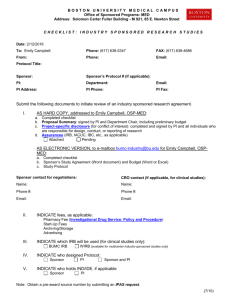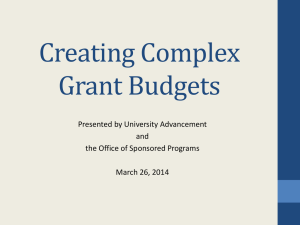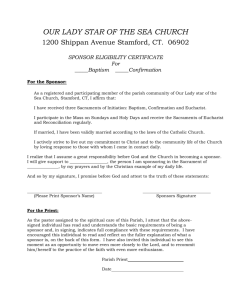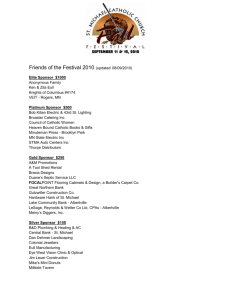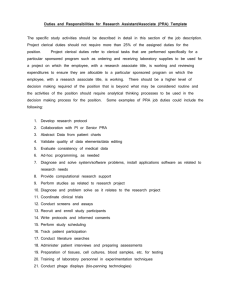SAMPLE FORMAT: BUDGET JUSTIFICATION
advertisement
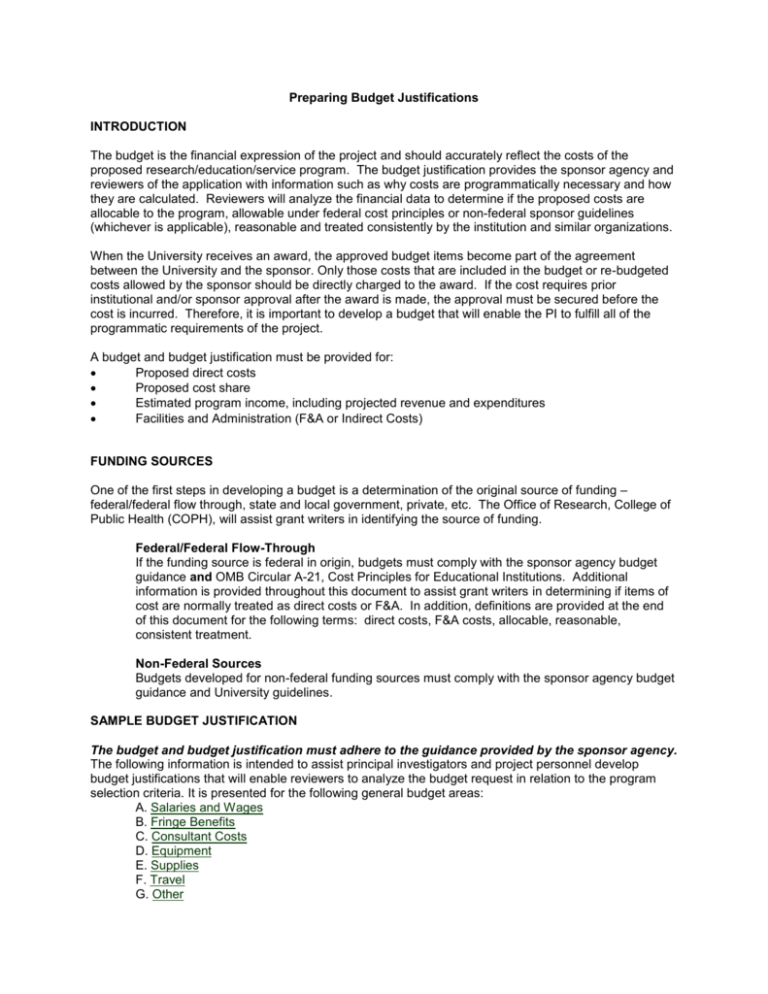
Preparing Budget Justifications INTRODUCTION The budget is the financial expression of the project and should accurately reflect the costs of the proposed research/education/service program. The budget justification provides the sponsor agency and reviewers of the application with information such as why costs are programmatically necessary and how they are calculated. Reviewers will analyze the financial data to determine if the proposed costs are allocable to the program, allowable under federal cost principles or non-federal sponsor guidelines (whichever is applicable), reasonable and treated consistently by the institution and similar organizations. When the University receives an award, the approved budget items become part of the agreement between the University and the sponsor. Only those costs that are included in the budget or re-budgeted costs allowed by the sponsor should be directly charged to the award. If the cost requires prior institutional and/or sponsor approval after the award is made, the approval must be secured before the cost is incurred. Therefore, it is important to develop a budget that will enable the PI to fulfill all of the programmatic requirements of the project. A budget and budget justification must be provided for: Proposed direct costs Proposed cost share Estimated program income, including projected revenue and expenditures Facilities and Administration (F&A or Indirect Costs) FUNDING SOURCES One of the first steps in developing a budget is a determination of the original source of funding – federal/federal flow through, state and local government, private, etc. The Office of Research, College of Public Health (COPH), will assist grant writers in identifying the source of funding. Federal/Federal Flow-Through If the funding source is federal in origin, budgets must comply with the sponsor agency budget guidance and OMB Circular A-21, Cost Principles for Educational Institutions. Additional information is provided throughout this document to assist grant writers in determining if items of cost are normally treated as direct costs or F&A. In addition, definitions are provided at the end of this document for the following terms: direct costs, F&A costs, allocable, reasonable, consistent treatment. Non-Federal Sources Budgets developed for non-federal funding sources must comply with the sponsor agency budget guidance and University guidelines. SAMPLE BUDGET JUSTIFICATION The budget and budget justification must adhere to the guidance provided by the sponsor agency. The following information is intended to assist principal investigators and project personnel develop budget justifications that will enable reviewers to analyze the budget request in relation to the program selection criteria. It is presented for the following general budget areas: A. Salaries and Wages B. Fringe Benefits C. Consultant Costs D. Equipment E. Supplies F. Travel G. Other H. Contractual Costs I. Facilities & Administration (F&A) or Indirect Costs RESOURCES Additional resources appear at the end of this document: Definitions: Cost Principles for Educational Institutions OMB Circular A-21 Examples of a major project where direct charging of administrative staff salaries may be appropriate References A. Salaries and Wages Provide the following information for each position identified on the budget: 1. Name 2. Degree(s) 3. Title 4. Time commitment 5. Duties and responsibilities in relation to the program goals and objectives Federal/Federal Flow-Through: Administrative and clerical positions are normally treated as Facilities and Administration (F&A), but may be charged to a sponsored project when ALL of the following conditions are met: 1. The cost can be readily identified specifically with the project with a high degree of accuracy. 2. The cost is incurred for a different purpose or circumstance as compared to administrative and clerical services that are normally treated as F&A. The budget justification should state that the costs are normally treated as F&A by the institution, but are requested due to a special purpose or circumstance. The special purpose or circumstance should be clearly outlined in the budget justification. a. The work to be performed is different from the administrative and clerical services that are required for routine departmental and administrative support. b. The work to be performed is required to meet the exceptional requirements of the project. Direct charging of these costs may be appropriate where a major project or activity explicitly budgets for administrative or clerical services. “Major project” is defined as a project that requires an extensive amount of administrative or clerical support which is significantly greater than the routine level of such services provided by academic departments. Examples of “major projects” where direct charging of administrative or clerical staff salaries may be appropriate are provided at the end of this document. 3. The cost is explicitly budgeted, with a reasonable justification given for direct charging due to a special purpose or circumstance, and approved by the sponsor agency. Examples: Evaluation Specialist/Research Associate – Name, Degree(s) The Evaluation Specialist is responsible for developing and implementing the evaluation component of the project. This position will develop instruments for the collection of evaluation data and will collect, analyze and synthesize data gathered for presentation to the project staff, advisory committee, and stakeholder groups. This individual will work with content specialists in the assessment and validation of student mastery of the curriculum and course content. The position has responsibility for the summative evaluation of the training program. FTE: 50% Program Assistant – Name, Degree(s) The Program Assistant provides administrative support for the statewide Maternal and Child Services Workforce Development Program. This position will coordinate communications among six pilot sites, a statewide advisory committee, multiple stakeholder groups, and other program constituents. The Program Assistant will coordinate logistics for up to four training programs per year (25-40 attendees per training program). This individual will research and identify potential training facilities; process contracts for meeting room and audiovisual equipment rental; prepare and disseminate training announcements; make travel arrangements for speakers and project personnel; prepare and disseminate travel reimbursement guidelines; prepare and submit travel expense reports for project staff, speakers, and supported attendees; prepare materials for registration packets (syllabi, training materials); and compile/tabulate training program evaluation data. This position also assists the Evaluation Specialist prepare IRB applications and renewals and assists professional staff in the collection of literature and data reviews relevant to the program. FTE: 1.0 Although normally treated as an F&A cost, the nature of the work described for the Program Assistant represents administrative or clerical support which is different from and significantly greater than the routine level of support services provided by the institution. In addition, the Maternal and Child Services Workforce Development program may be defined as a “major project” as follows: Large, complex programs, such as General Clinical Research Centers, Primate Centers, Program Projects, environmental research centers, engineering research centers, and other grants and contracts that entail assembling and managing teams of investigators from a number of institutions. Projects that require making travel and meeting arrangements for large numbers of participants, such as conferences and seminars. Individual projects requiring project-specific database management, individualized graphics or manuscript preparation; human or animal protocol, IRB preparations and/or other project specific regulatory protocols; and multiple project-related investigator coordination and communication. B. Fringe Benefits Indicate how fringe benefit costs are calculated, based on the types of positions for which funding is requested. Refer to the Division of Research Grants web site for current USF fringe benefit rates NOTE: Fringe benefit rates are updated periodically. Check the DRG web site prior to calculating fringe benefit costs. Example: Fringe benefits are calculated at 16.5% of requested salary dollars and include: FICA, Medicare, workers compensation, unemployment compensation, and retirement. In addition, health insurance is calculated as follows: Individual coverage - $289/month; Family coverage - $590/month. Fringe benefits for non-student OPS (Other Personnel Services) are calculated at 8% and include: FICA, workers compensation, and unemployment compensation. Fringe benefits for student OPS (including Graduate Assistants/Associates) are calculated at 1% and include: workers compensation and unemployment compensation. Personnel/fringe benefit costs may also include employment termination costs, i.e., accrued leave payments, severance pay allocable to the project and in compliance with USF policies and procedures. C. Consultant Costs Professional services may be obtained from individuals who are not employees of the grantee institution. The following information should be provided: 1. 2. 3. 4. 5. Name of consultant (if known) Organizational affiliation (if applicable) Nature of services to be rendered Number of days of consultation Expected rate of compensation a. Hourly or day rate b. Other – travel, per diem, other related expenses Example: Name, Degree(s) Funds are requested to conduct up to 10 training sessions pertaining to KidCare Program eligibility. The target audience includes enrollment personnel located in health departments, public health clinics, and other settings. Training sessions will be offered in locations throughout the state of Florida. Training programs will include: Basic Eligibility (4 sessions/year @ 6 hours/session), Advanced Training (4 sessions/year @ 4 hours/session), or Refresher (2 sessions/year@ 4 hours/session). Preparation and follow-up for each training course will not exceed 12 hours and will include consultation with HHS, INS, ORR or other offices or individuals. Basic Eligibility: Advanced Training: Refresher: 6 hrs trng + 12 hrs prep = 18 hrs/session x 4 sessions x $50/hr = $3,600 4 hrs trng + 12 hrs prep = 16 hrs/session x 4 sessions x $50/hr = $3,200 4 hrs trng + 12 hrs prep = 16 hrs/session x 2 sessions x $50/hr = $1,600 $8,400 Travel to training site locations will be reimbursed including airfare, mileage, lodging, meals, parking, and other travel related expenses. Travel costs are estimated as follows: $500/session x 10 sessions = $5,000 D. Equipment Requests for equipment should include the following information. Description Quantity Unit cost Justification for the use of each item related to specific program objectives: how the equipment will enable project personnel to fulfill the scientific objectives of the project, and how the use of such equipment will be solely allocable to the project. Federal/Federal Flow-Through: General purpose equipment such as furniture, desktop computers, printers, fax machines, etc., are normally treated as F&A. If the proposed funding is non-federal, refer to the sponsor budget guidelines for definitions of allowable equipment purchases. Example: Spectronic Genesys 2 Spectrophotometer: The Spectrophotometer measures the amount of light that the sample absorbs by passing a beam of light through the sample and recording the intensity of light reaching the detector. This instrument will be used to analyze samples generated from exhaled breath condensate, in particular, ammonia and amylase levels. The Spectrophotometer will be allocated solely to this project. 1 unit @ $6,450 High Performance Liquid Chromatograph with Fluorescence (HPLC) and UV-NIR: The HPLC will be used to evaluate the level of various breath condensate components including glutathione, ethane and ethylene. In addition, when coupled with a mass spectrometer, it is capable of measuring overlapping volatile components also found in breath condensate. Use of the HPLC will be solely allocable to this project. 1 unit @ $44,345 E. Supplies To the extent possible, list: Item description Quantity Unit cost Total amount Federal/Federal Flow-Through: General office supplies normally cannot be included as direct charges to federal awards since these types of costs are included in the negotiated F&A rate. General office supplies include paper, pencils, pens, ink, toner cartridges, etc. These items of cost are considered readily expendable and are treated as F&A. The only exceptions are those in which the purchase of supplies is extensive in nature, can be specifically identified to the project and meets the definition of a direct charge. Example: MycoMeter sample kits: MycoMeter kits are necessary to periodically monitor the fungal growth on painted gypsum drywall. The generation of trimethylstibine is believed to be linked to the growth of fungi. Measurements of an indicator of fungal biomass should correlate with the generation rates of trimethylstibine. 175 kits @ $25/kit = $4,375 The following supplies are required to create a registration packet, program syllabus and training materials to be distributed to participants of the training program, “Hearing Conservation in Industry.” The estimated attendance is 150. A CD will be distributed to each attendee to be used during training sessions conducted in the computer lab. A writing pad and pencil will be provided to facilitate note taking. In addition, each attendee will receive a certificate of completion at the conclusion of the program. 2” Three-ring notebooks Index divider sets CD-R, 650 MB #2 Pencils Writing pads Certificate paper Name badges 150 notebooks x $2.36 ea = 150 sets x $1.89 ea = 150 CDs x $.92 = 13 boxes (12) x $.80 = 13 pkg (12) x $7.98 = 6 packet (25) x $4.42 = 3 boxes (50) x $19.32 = 354.00 283.50 138.00 10.40 103.74 26.52 57.96 $974.12 F. Travel Provide a breakdown of travel costs including: Purpose of trip Name/position of traveler To the extent possible, itemize per person travel costs: airfare, lodging, meals, car rental, parking, mileage, registration fees, etc. Number of trips Total costs Examples: 1. The Research Associate will travel to six pilot sites, twice per year, to supervise data collection and conduct quality assurance monitoring. In-State Travel: Two days/one night: $493/Person/Trip Air Fare $200/person Lodging $125/night Meals $21/day x 2 days = $42 ($3-Breakfast, $6-Lunch, $12-Dinner) Rental Car $40/day x 2 days = $80 On-Site Parking $10/day x 2 days = $20 Airport Parking $7/day x 2 days = $14 Mileage to Airport 40 mi RT x $.29/mi = $11.60 $493/person/trip x 10 trips = $4,930 2. The Project Director will travel to Washington, DC twice per year to meet with the program officer and other grantees to review program progress and issues related to implementation and evaluation. Out-of-State Travel: Three days/two nights: $1,026/Person Air Fare $400/person Lodging $175/night x 2 nights = $350 Meals $21/day x 3 days = $63 ($3-Breakfast, $6-Lunch, $12-Dinner) Rental Car $40/day x 3 days = $120 On-Site Parking $20/day x 3 days = $60 Airport Parking $7/day x 3 days = $21 Mileage to Airport 40 mi RT x $.29/mi = $11.60 $1,026/person/trip x 2 trips = $2,052 G. Other This category contains items not included in the previous budget categories. Individually list each item requested and provide appropriate justification related to the program objectives. Federal/Federal Flow-Through: The following items are normally treated as F&A: Postage expense incurred in support of routine administrative communication activities including mailing technical reports and other project deliverables are treated as F&A. Postage expenses include US mail, overnight mail, UPS, etc. The only exceptions are those cases where extensive postage expense is required in support of the goals and objectives of the project, e.g., mailing a large number of surveys, mailing conference brochures. Requests to direct charge postage to federal dollars must demonstrate that the postage will provide a direct benefit to the purpose of the project, is extensive, and can be specifically identified with the project. Telephone and communication expenses incurred in support of routine administrative activities should not be charged directly to federal dollars, e.g., installation costs, monthly recurring telephone costs, pagers, etc. Exceptions to this rule include long distance calls (telephone and fax) incurred for the sole direct benefit of the project. Examples: Long-distance toll calls: Project personnel will communicate with pilot sites, sponsor agency, other program grantees, advisory committee and other constituents. Costs are estimated as follows: $25/person/month x 4.5 project FTEs = $112.50/month x 12 months = $1,350 Subject Fee Payments: Incentives will be provided to solicit participation in three focus group meetings. The focus group sessions will be designed to ascertain barriers encountered by consumers who seek prenatal health care services. 25 participants/focus group x $50/participant x 3 focus group mtgs = $3,750 Tuition: Funding is requested for two Graduate Research Assistants (GA) under the “Personnel” budget category. In addition to salary support, in-state tuition costs will be provided as follows: $209.53/credit hour x 9 hours/semester x 3 semesters x 2 GAs = $11,314.62 The PI/Project Staff may request tuition waivers for Graduate Assistants, if allowable per the sponsor budget guidance and sufficient funding is available. H. Contractual Costs If a portion of the scope of work will be assigned to another institution or organization, the following information should be provided: 1. Name of subrecipient 2. Period of performance 3. Scope of work 4. Itemized budget and budget justification (Each proposed subrecipient must provide a budget and budget justification in compliance with the sponsor agency budget guidance.) Centre for Women/Family Service Association Performance Period: July 1, 2004 – June 30, 2005 Scope of Work: The Centre for Women/Family Service Association will provide the services of a Benefits Coordinator and Licensed Mental Health Worker to consumers of the Central Hillsborough Healthy Start Program (CHHS). This organization is well respected in the community for its culturally competent and respectful service provision. The Centre for Women will: a) provide individual and group therapy services, b) coordinate clinical and non-clinical mental health services; c) provide psycho-educational and support groups, d) participate in the evaluation of quality and quantity of services of the maternal depression program as required by CHHS; e) participate in data collection, and f) provide monthly written reports on the activities and progress towards the achievement of project goals to the Project Director. PERSONNEL Name TBA TBA Role on Project Licensed Social Wrk Benefits Coord Inst. Base Salary $40,000 Salary Requeste d $40,000 Fringe Benefits Total 1.0 Mo s 12 $10,400 $50,400 .50 12 $25,000 $12,500 $3,250 $15,750 FTE Travel: In-State $ Total Direct Costs F&A @ 10% Total Costs $66,672 $ 6,667 $73,339 522 Licensed Social Worker – Name, Degree(s) Provides clinical oversight of the day-to-day operations of the CHHS maternal depression program; reviews all depression screens, assign levels of care and linkages for services to program participants; provides assessments, individual therapy, and crisis intervention; provides clinical supervision to the Benefits Coordinator; attends monthly Interagency Management team meetings and Community Council meetings; provides group therapeutic sessions; and provides continuing education for the Care Coordination Team.. Group therapy topics may include, but are not limited to, anger management, time management domestic violence, effective parenting and self- advocacy. Continuing education topics include: signs and symptoms of maternal depression, mandatory neglect/abuse reporting, and signs and symptoms of depression and adjustment disorders. Benefits Coordinator/Clinical Case Manager – Name, Degree(s) This position facilitates ongoing consumer peer support groups for individuals who have completed individual and group treatment focusing on inter-conceptual care; coordinates psychiatric and medication management services; provides psycho-educational services to consumers regarding policies and procedures of various health care and assistance programs; facilitates linkages between consumers and community resources through the modeling of advocacy and empowerment strategies in group and individual meetings; reviews all cases of program participants and consults with the interdisciplinary team as appropriate to assist in the maximum utilization of community resources by consumers; educates consumers regarding policies and procedures of various health care and assistance programs and helps link consumers to these programs. Fringe Benefits Fringe benefits are calculated at 25% of salary dollars requested and include: FICA, Medicare, workman’s compensation, retirement, and health benefits. Travel The Licensed Social Worker may provide therapy services in public health clinics, consumer homes, and other settings. In addition, this position is required to attend two project-related meetings per month and conduct training programs throughout the year, to be determined in conjunction with the Project Director. 1,800 miles x $.29/mile = $522 F&A: The F&A rate specified in the budget guidance provided by Health Resources and Services Administration, PHS, DHHS, is 10% of total direct costs. I. Facilities & Administration (F&A) or Indirect Costs F&A or indirect costs must be calculated in compliance with the budget guidance provided by the sponsor agency. If the sponsor does not specify a rate, refer to the following USF web site or contact the COPH Office of Research for assistance in determining the appropriate F&A or indirect cost rate. USF web site for indirect cost rates DEFINITIONS OMB Circular A-21 Cost Principles for Educational Institutions Direct Cost: Costs that can be identified specifically with a particular sponsored project, an instructional activity, or any other institutional activity, or that can be directly assigned to such activities relatively easily with a high degree of accuracy. Costs incurred for the same purpose in like circumstances must be treated consistently as either direct or F&A costs. Where an institution treats a particular type of cost as a direct cost of sponsored agreements, all costs incurred for the same purpose in like circumstances shall be treated as direct costs of all activities of the institution. F&A Costs: Costs that are incurred for common or joint objectives and, therefore, cannot be identified readily and specifically with a particular sponsored project, an instructional activity, or any other institutional activity. Reasonable: A cost is considered reasonable if the nature of the goods or services acquired and the amount involved reflect the action that a prudent person would have taken under the circumstances prevailing at the time the decision was made to incur the cost. Allocable: A cost is allocable to a particular sponsored project if the goods or services involved are chargeable or assignable to the project in accordance with the relative benefits received. Consistent Application of Cost Accounting Principles: Costs incurred for the same purpose in like circumstances must be treated consistently as either direct or indirect costs. Where the University treats a particular type of cast as a direct cost on sponsored agreements, all costs incurred for the same purpose in like circumstances must be treated as direct costs for all activities of the institution. Consistent treatment of costs is necessary to avoid inappropriate charges to the federal government or other sponsors when sponsored agreements are charged directly for specified costs, then charged again through the University’s indirect cost rate. PIs, department administrators, and in some specific instances, central administration officials should review costs to ensure that they are allowable and allocable to a project. Size, nature and complexity of sponsored agreements, although not the final determining factor, are in the aggregate important considerations in determining unlike circumstances. Due to the unique requirements of each sponsored agreement, unlike circumstances are determined on a case-by-case basis. OMB Circular A-21 Cost Principles for Educational Institutions Examples of a “major project” where direct charging of administrative or clerical staff salaries may be appropriate. Large, complex programs, such as General Clinical Research Centers, Primate Centers, Program Projects, environmental research centers, engineering research centers, and other grants and contracts that entail assembling and managing teams of investigators from a number of institutions. Projects which involve extensive data accumulation, analysis and entry, surveying, tabulation, cataloging, searching literature, and reporting, such as epidemiological studies, clinical trials, and retrospective clinical records students. Projects that require making travel and meeting arrangements for large numbers of participants, such as conferences and seminars. Projects whose principal focus is the preparation and production of manuals and large reports, books and monographs (excluding routine progress and technical reports). Projects which are geographically inaccessible to normal departmental administrative services, such as seagoing research vessels and other research field sites that are remote from the campus. Individual projects requiring project-specific database management, individualized graphics or manuscript preparation; human or animal protocol, IRB preparations and/or other project specific regulatory protocols; and multiple project-related investigator These examples are not an exhaustive list, nor do they imply that direct charging of administrative or clerical salaries would always be appropriate for the situations illustrated in the examples. For instance, the examples would be appropriate when the costs of such activities are incurred in unlike circumstances, i.e., the actual activities charged direct are not the same as the actual activities normally included in the institution’s F&A cost pools. It would be inappropriate to charge the cost of such activities directly to specific sponsored agreements if, in similar circumstances, the costs of performing the same type of activity for other sponsored agreements were included as allocable costs in institution’s F&A cost pools. REFERENCES OMB Circular A-21: Cost Principles for Educational Institutions http://www.whitehouse.gov/omb/circulars/a021/a021.html Introduction to Cost Accounting Standards for Educational Institutions http://www.research.usf.edu/sr/CAS_Policies_and_Procedures_3.htm A Guide to Managing Federal Grants for Colleges and Universities, J.T. Norris and J.A. Youngers, F. Fernald (Exec Editor), National Association of College and University Business Officers (NACUBO) and the National Council of University Research Administrators (NCURA) in conjunction with Atlantic Information Services, Inc. (AIS), 2003. Revised 12/15/03
